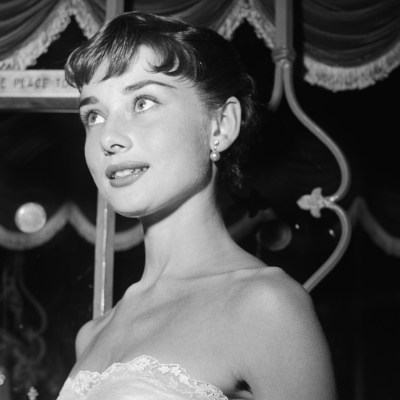Jimmy Stewart and the WW2 Mission That Almost Broke Him
Jimmy Stewart rarely talked about his World War II experience after returning from the service, but intense air force battles over Europe left lifelong scars.
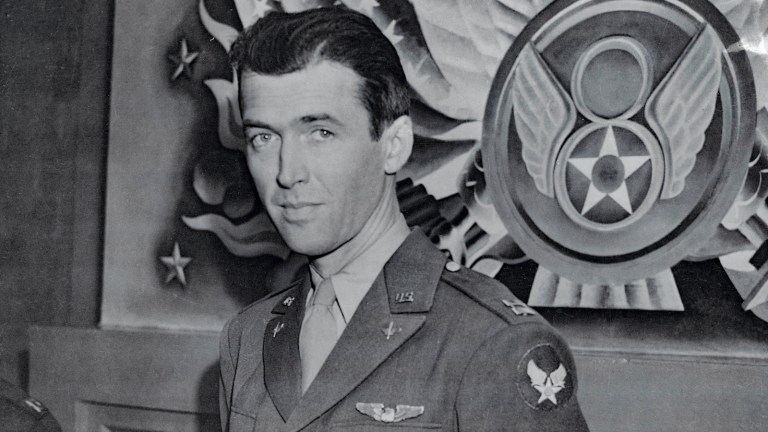
The sound of the impact is deafening. More than 18,000 feet above the German city of Fürth, the World War II B-24 bomber they call Dixie Flyer has just delivered its full payload onto a German manufacturer, devastating its ability to build military aircraft and turning the airfield into a scrap heap. But even before making the full turn out of Bavaria, Dixie Flyer’s copilot and the leader of this bombing group, Maj. James Stewart (Jimmy Stewart to his fans), is nearly lifted out of his chair.
That’s because a German shell (or flak) has pierced directly through the center of his B-24 Liberator. The whiplash is so intense that only harnesses keep him in his seat. Still, Stewart rises in the air; pilot Capt. Neil Johnson’s hands are briefly shaken from the controls; and for a moment, the entire plane is consumed with smoke as it violently ascends. When Stewart finally gets his bearings, he’s able to look down and see the hole in the aircraft—the edge of it is inches from his boot. Almost two feet in width, the gap offers a clear view through the plane’s fuselage and straight on to the German landscape below.
There is little time to worry though. The German ground defenses and their 88mm shells are rattling the sky with more flak, and out of the corner of his eye, Stewart can see one of his planes, and his crews, also get hit. They’re not so lucky as a wing comes off and the craft falls to the earth. Meanwhile, German Focke-Wulf 190 fighters are beginning to swarm.
Stewart’s 445th Bombing Group only have each other and the tightness of their formation for protection—the Eighth Air Force and RAF fighters that accompanied the mission are spread too thin across the rest of Operation Argument’s ambitious list of targets to help—and they’re a long way from home.
It was the fifth day of the Eighth Air Force’s Big Week in February 1944, and Stewart was on his 10th combat mission in the air as either a group, wing, or squadron leader. This is what he left Hollywood for, circumvented Louis B. Mayer to participate in, and felt a lifetime of obligation to fulfill. It would be his finest moment in the air. It also would be the one that almost broke him.
The Mission of a Lifetime
Long before he entertained the idea of movie stardom, James Maitland Stewart felt the call of military service. In many ways, it was viewed as his birthright. His father’s father, the original James Maitland Stewart, served in the Union Army during the Civil War, participating in the valley campaigns of Shenandoah and serving under Gen. Philip Sheridan and a young officer named George Armstrong Custer. His maternal grandfather was at Gettysburg and Fredericksburg (he would die before “Jimmy” was born). And as a boy in the 1910s, the younger James Stewart would sit on his namesake’s knee, hearing eyewitness accounts about the war that preserved the United States.
Around the same time, young Jim was also receiving German helmets and paraphernalia shipped home by his father Alexander Stewart, who was off in Europe serving in World War I. Jim would use these real mementos of war in the makeshift plays he’d put on at his home in Indiana, Pennsylvania.
Biographer Robert Matzen, who authored the definitive account of Stewart’s World War II years, Mission: Jimmy Stewart and the Fight for Europe, tells us this background had a formative influence on the rest of Stewart’s life and his sense of duty, which he carried with him on the train to Hollywood and then, eventually, on the plane ride out of it.
“All of these things added up into this sort of nexus of ‘I will serve, I have to serve, it’s my duty, it’s my time,’” Matzen says during a Zoom conversation. “And when the time came, he answered the bell. He was so fast out of the gate in the sweepstakes for World War II that he was in the first draft class. He willingly went. It’s not that he enlisted, he was drafted, but he was happy to be drafted. He called it winning the lottery.”
Indeed, Stewart’s then-recent status as a movie star of the 1930s was practically an accident, at least as far as MGM, the studio which held his contract, was concerned. The studio’s top brass viewed Stewart as a possible character actor or background comic talent. But then Frank Capra saw the everyman appeal in Jim’s thin frame and irrepressible earnestness, and cast him in You Can’t Take It with You (1938) and Mr. Smith Goes to Washington (1939)—on loan at Columbia Pictures.
Stewart of course positioned himself to have that career, just as he positioned himself to be ready to serve if his country ever needed him. Hence alongside his sense of service and sacrifice, he also carried a passion for flying. And as soon as his movie star bona fides were cemented, he celebrated by flying his personal aircraft, a military trainer, learning his way around the skies.
“There’s so many things to think about up there that you forget things down below,” Stewart told an interviewer in the late 1930s. “Flying is something altogether different from the way I’m earning my living. That’s what I like about it… Flying is sort of a guarantee that life will continue to have variety.”
According to biographer Matzen, it also was a guarantee he’d be ready to serve when the time came.
“Step by step, he set himself up to end up in England in a bomb group,” Matzen says. “One of those steps was taken years before he was drafted, and that was when he became a star in Hollywood and bought a plane that was an army trainer and proceeded to learn to fly and train, and log hours on that plane so that he could be a pilot when the war came. And war seemed inevitable by 1938.”
Stewart even used his off-time to prepare for it. Says Matzen, “He took out a trip to Europe toward the end of ’39 to get the lay of the land because he thought he was going to end up fighting there.”
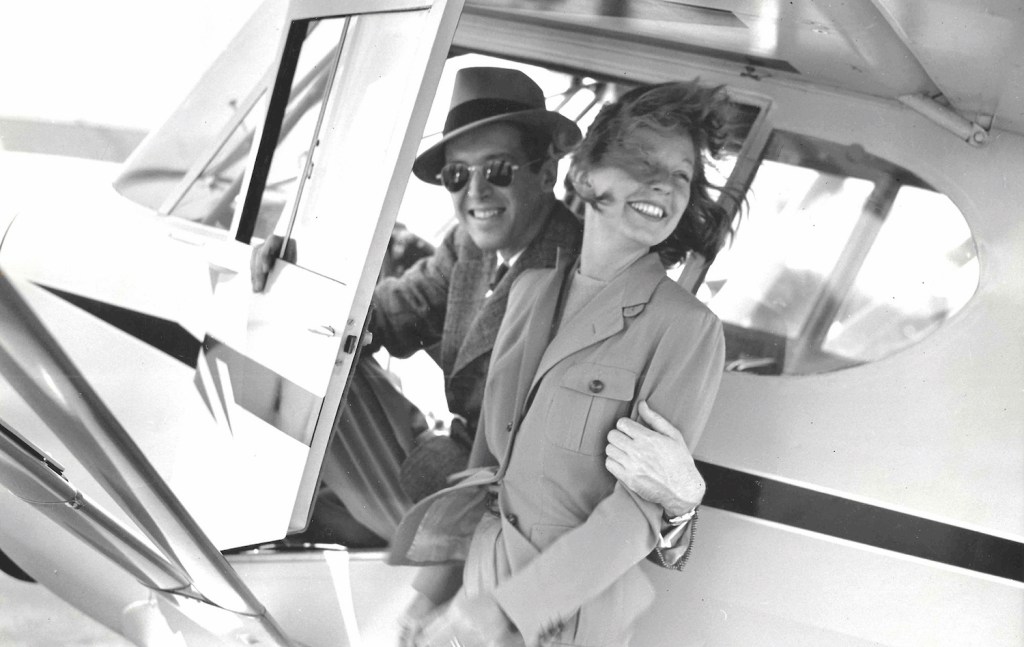
The ‘I’m a Movie Star’ Card
That preparation served Jim well. While he was initially rejected from service in 1940—more than a year before the Japanese attack on Pearl Harbor—his capability as a flyer, and ability to find a doctor to explain that this 32-year-old man’s unusually thin frame was due to genetics and not ill-health, kept him in line to not only be drafted early but excel in the U.S. Army Air Corps.
“He was deferred in October of 1940 and his father was furious,” says Matzen. “He thought that Jim was in on the deferment for some reason. And Alex called him and chewed him out, and it made the papers that his father chewed him out. But it wasn’t anything. That’s what I think sent Jim back to talk to that doctor and get this letter written that was his carte blanche to get into the military.” That same letter was also the first record Matzen found at the top of Stewart’s military file more than 70 years later. It was the piece of paper which got him into the service and, along with his capability as a flyer, helped him rise all the way to the rank of brigadier general while serving in the Air Force Reserve in the 1950s.
That talent is also how Stewart circumvented the wishes of commanding officers and Louis B. Mayer, who likely applied pressure on the government to keep Stewart stateside during the war, essentially to make propaganda films for the First Motion Picture Unit.
“Jim was furious when that happened, because that was not his intention,” Matzen says. “He was a movie star of the first order who walked away from Hollywood. He took his fame with him and it did allow him to speak to officers that otherwise would not talk to a private and then a corporal, and then a second lieutenant. He got his way by playing the ‘I’m a movie star’ card. But it wasn’t, ‘I’m a movie star, don’t send me in harm’s way.’ It was just the opposite.”
In November 1943, Stewart would get his wish when he was sent to England as part of the 445th Bombardment Group in the Eighth Air Force.
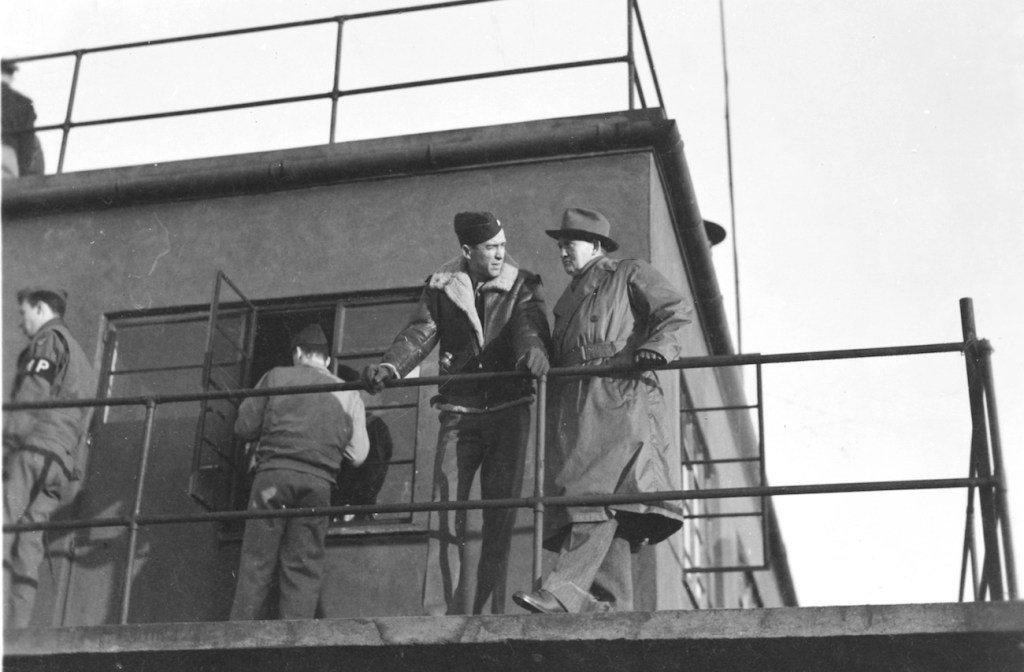
Squadron Leader
Stewart almost never spoke about his experiences during the war. Just as he would refuse to ever star in a World War II picture, he abjectly refused to give an interview to the press after arriving in Tibenham, a remote and perpetually damp village in East Anglia. His reticence is even the reason Matzen was first wary of writing a book about Stewart’s war experiences. Yet, for whatever personal recalcitrance the actor had toward talking, the story left by his military file, records of his bombing runs, and even the testimonials, diary entries, and occasional published memoirs of the men under his command paint a strong picture.
As the oldest man on the plane and in the air—with his pilots frequently being between ages 19 and 23—Stewart offered a precise and measured authority that made him a natural leader who was too good to keep stateside.
Air Corps officer Beirne Lay Jr. recalled, “Things seemed to go all right when Stewart was up front. He made free use of the radio, like an aerial quarterback, to advise and encourage the other boys during a mission, and here his experience in films gave him a novel advantage. Because of his precise enunciation, people could understand him. It sounds like a little thing, but clear, quick communication between formations was of extraordinary importance.”
The talent made Stewart a natural choice to become a commanding officer in the 445th. Always from the copilot seat of a B-24 Liberator bomber, Stewart would command anywhere between 25 to 150 aircraft, depending on if he was lead, wing, or squadron commander. But even on the days he didn’t fly with the men he trained, he would brief his boys about the day’s missions. Then came the long wait in the cold mud of Tibenham, below the radio tower of Station 124. Those hours of seeing if all his crews would return felt interminably longer than actually flying the missions.
“He had very few of what they call milk runs,” Matzen says, “which were the easy ones where you hopped over the North Sea to the Netherlands or you hopped over the Channel to the coast of France, and you bombed something easy: a submarine pen here or a gun emplacement there. His very first mission was to Kiel in the very Northern tip of Germany, near Denmark, to bomb submarine pens. It was this long mission east over the North Sea.” It was a clean one on a bright December day, despite encountering countless rounds of flak.
A few weeks later, they would not be so easygoing. On Jan. 7, 1944, Capt. Stewart was wing lead of the 445th when the 389th, the lead bombing group that day, took a wrong turn over the Rhine. The formations had successfully carried out a bombing raid of the German city of Ludwigshafen, but the 389th turned at a mistaken angle that put their return flight on a path over Nazi occupied Paris instead of Tibenham.
Despite the 389th ignoring Stewart’s radio communication, the 35-year-old officer made the even-headed choice to follow the 389th and keep formation tight (as opposed to creating chaos and isolation in the sky), which came in handy after the 389th inevitably became a target of the German Luftwaffe air force outside of Paris.
American Thunderbolts and British Spitfires ended up saving the 389th that day, which still lost several planes and even more lives, but the tight flying of the 445th led the Luftwaffe to not even tangle with Stewart’s group.
It was the mission that earned Jim the rank of major. His confidence grew, yet day by day, and mission by mission, the stress likewise increased as he saw fewer faces he trained return home. For instance, on one mission, Stewart’s aircraft suffered engine troubles while crossing the English Channel and had to return home. The plane that took their place in the formation as group leader, the Liberty Belle, was shot down in their place. Only three parachutes were spotted getting out in time.
Similarly, Jim was at the barracks in December 1943 when they celebrated the 22nd birthday of his pilot Dave Skjeje. In February, he was writing to Billie, Dave’s widow of the same age, about how her newlywed husband died.
“He was told don’t get personally involved,” Matzen says. “There is a hierarchy here and he stuck to that pretty well, but he also was the one to write the letters to families, to wives, to mothers and fathers when somebody was lost, and it really weighed on him.”
It would soon reach a tipping point.

“The Roughest 10 or 15 Minutes”
Operation Argument (aka “Big Week”) was the campaign the Eighth Air Force spent the winter of 1943/44 waiting on. In the span of six days, the U.S. military would drastically ramp up its daytime precision bombing campaign and cripple the Luftwaffe ahead of what would become the D-Day invasion.
Says Matzen, “The Eighth Air Force was determined to knock out the German aircraft manufacturing capabilities, so they looked for one week where they could have clear weather to have a series of campaigns, bombing missions to hit strategic targets related to aircraft manufacturing. Those missions were extremely dangerous.”
Jim flew the first day of Big Week over the Netherlands. It was considered a major success even though three planes in the 445th went down. One of his pilots called it “the roughest 10 or 15 minutes I ever spent.” But it was about to get much worse for the 445th.
On Feb. 24, Stewart was standing below Station 124’s tower when the remnants of the day’s planes limped home, some of them still smoking and on fire. Twenty-eight planes had taken off that morning, headed for the German city of Gotha, but three needed to return due to technical troubles while over the English Channel. Of the remaining 25 bombers in the air, only 12 returned to East Anglia. More than half had been shot down.
The next day, Jim would lead the 445th again in the skies for his second Big Week mission… over Fürth, an area just northwest of Nuremberg. The mission was part of an ambitious push that would send 754 B-17s and B-24s, with an escort of 20 groups of Eighth Air Force fighters and 12 squadrons of RAF Spitfires and Mustangs, into southern Germany to attack three Messerschmitt aircraft production centers and a ball-bearing plant.
With the bomb bay doors open at 18,500 feet, the air was already 40 degrees below zero in a Bavarian February. After a 88mm shell nearly blew a hole between Stewart and pilot Neil Johnson’s feet, the temperature was dropping around their oxygen masks so quickly that ice began forming inside of the plane and on their gear.
Immediately after Dixie Flyer was hit, the first of several planes in the 445th went down in the hail of flak. Stewart could see as the wings of one B-24 under his command came off and the aircraft disintegrated midair. Only one parachute made it out as the rest of the crew plummeted. Perhaps it was in this moment that Stewart noted his crew’s parachutes were already sucked out of the vacuum in Dixie Flyer when the shell hit.
“How he didn’t die that instant is amazing,” Matzen says. “He looked over to his left and another plane [Nine Yanks and a Jerk] had a shell go directly through the cockpit on one side and out the other, and he thought that the pilot and co-pilot certainly must’ve been killed, and that plane was going to go down. But they lived, they made it back too. It was crazy.”
Relief from Allied fighter planes never came, but most of the 445th somehow made it back to the English Channel that day, with Dixie Flyer and Nine Yanks and a Jerk limping home. Indeed, with its fuselage in tatters, Dixie even lost two of its engines before it saw the English coastline. While running on fumes, Johnson and Stewart had to use every muscle in their fiber to brake the collapsing plane when it finally landed at Tibenham. The pair were unaware at that moment that their plane was literally breaking apart as it touched down, with a crack ripping from the bulkhead to the cockpit.
The plane’s bombardier Jim Myers recalled, “[Stewart] was blue from the cold whistling through the holes in the plane, but he hadn’t received a scratch.” At least not physically.
As Matzen says now, “It was very interesting. The plane cracked and Jim cracked.” No one officially ever said Maj. Stewart became “flak happy” (the Air Force nickname for PTSD at the time) after the mission over Fürth, but Matzen contends no one needed to. In the first instance since December, more than two weeks passed before his CO allowed Stewart to go back in the air.
“This was the first time that he had to miss turns in the rotation, the leadership rotation leading missions,” Matzen says. “And that’s a huge deal to him. That’s him letting himself down in his crazy dedicated mind, in his perfectionist mind. All of a sudden, he’s not up to commanding in the air because he had been flying steady, steady, steady, then all of a sudden you look after February 25th, and he didn’t fly again till March 15th, and that’s a long time for him, and then he flew again on March 25th, then he didn’t fly again at all for a while.”
The pressure of leading, and perhaps more acutely the pressure caused by seeing so many of the men he trained go down, at last got to him.
Says Matzen “He had to just do what a lot of them did, which is go off into the country, take sodium amytal, and just chill and get reprogrammed. They’d sit and they’d talk to you, and they would give you perspective and they’d calm you down. Then they sent you back online.”
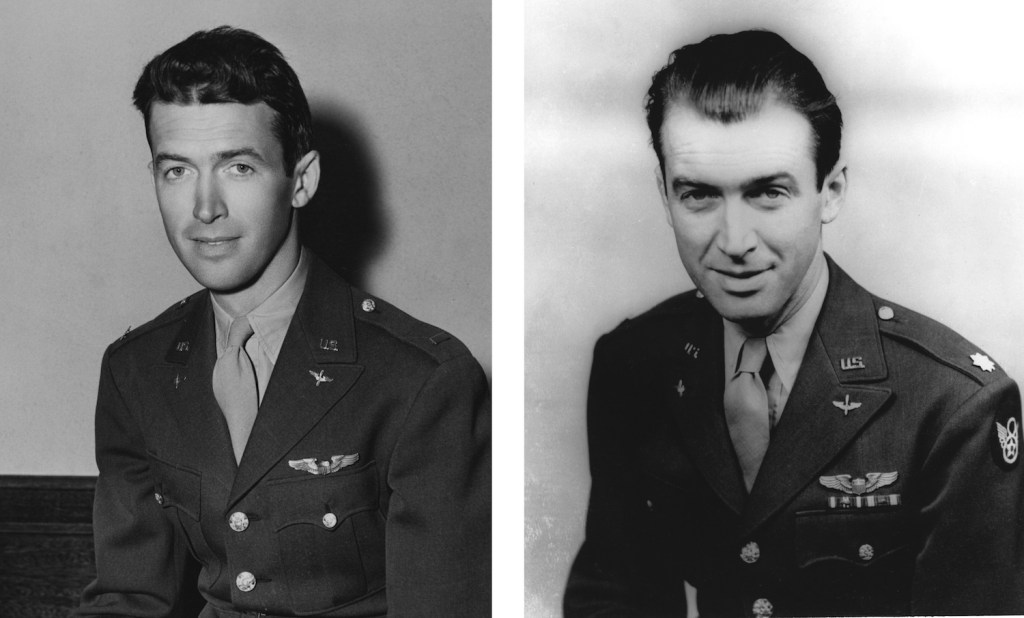
After the War
Jim would fly two more missions as group leader of the 445th, including a bombing run over Berlin. However, the gaps between the final two of his dozen missions in the 445th belied that he was essentially becoming grounded. Shortly after his run over Berlin, he reluctantly accepted a transfer to the 453rd in Old Buckenham. He effectively became a chief of staff there, briefing the crews of his new group, including on the bombing runs in June 1944 that paved the way for D-Day. To his regret, Stewart did not fly on any of those tactical missions.
He eventually would make it back into the air, leading a total of 20 combat missions, although by his final mission in 1945, the Luftwaffe was all but destroyed and a near collision course between bombing groups under his command convinced Stewart and his commanding officers that his time in the air was done—Stewart even vowed never to fly again (he did not keep that oath).
When he finally returned to the States in the fall of ’45, the gawkish and youthful leading Mr. Smith had vanished. Graying and gaunt—features which came from spending the end of the war so stressed he could only keep peanut butter and ice cream down for weeks at a time—Stewart was nearly unrecognizable to his proud parents when he disembarked off the Queen Elizabeth in New York. He was also unsure if he’d ever work in Hollywood again.
“He was ever thinner with skin hanging from him” says Matzen, “He lost his hair and the rest of it went gray. That’s what dragged himself back from Europe and arrived in Hollywood. He thought he was only fit for character parts now.”
Like the first time he arrived in Hollywood, the only person waiting for him at the Pasadena train station in 1945 was his old acting buddy Henry Fonda. While Hank had maintained his movie star status during the early part of America’s WWII years, he ended up following Jim into military service by joining the Navy. But he also had taken a shorter break from the silver screen. When Stewart arrived back, the only place he had to move was Hank’s “play house,” a small home he built in his mansion’s backyard for his children Peter and Jane Fonda. But Hank assured Jim, it had a fully functional kitchen and bar. Priorities were covered.
“They just decompressed together,” Matzen says, “and I think Hank saw what the toll had been on Jim and just helped him. Neither of them was a big talker. So they came back together and they started building model airplanes, which is what they had done before the war. They flew model airplanes, they flew kites, Fonda had access to these war surplus military grade kites that they would take out and fly together and do their thing: not talk much, listen to records, make airplanes, and re-assimilate in the peacetime world.”
Hank also helped Jim get a new agent to adjust to the postwar Hollywood where actors could truly be free agents. Which came in handy since MGM terminated Jim’s contract after he refused Mayer’s idea of capitalizing off Jim’s wartime service with an adventure movie about him as an ace pilot called The James Stewart Story. According to Stewart, after he flatly refused to do the movie, LB called him a son of a bitch and said “you’ll never work in this town again.”
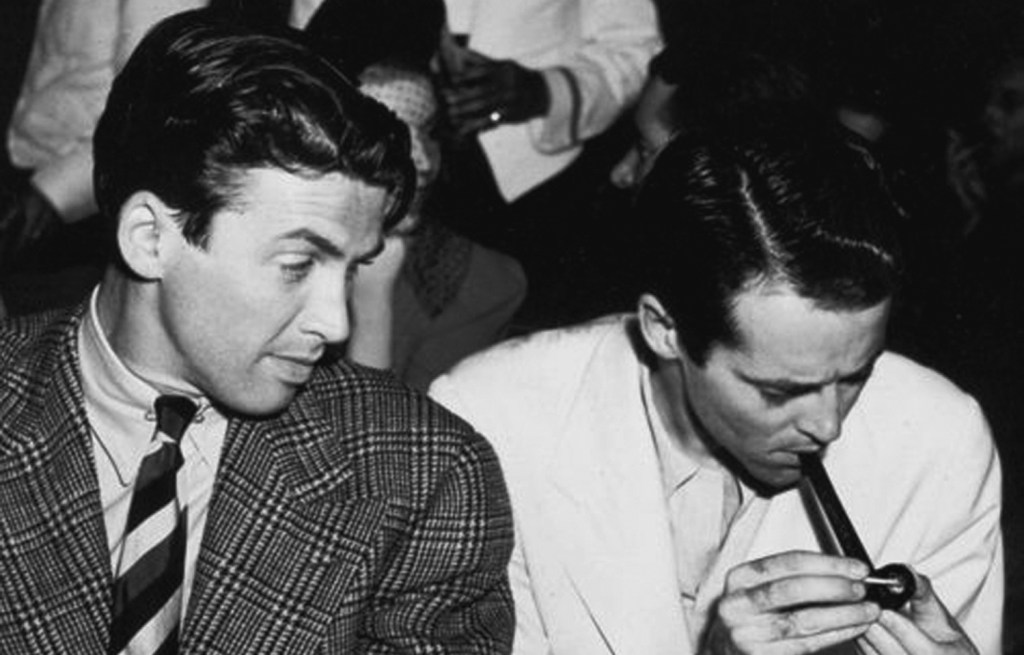
It’s a Wonderful Life
Of course Stewart did work again, making his comeback in the film he is still probably best remembered for: Frank Capra’s seminal holiday classic, It’s a Wonderful Life (1946). Like Stewart, Capra had enthusiastically joined the military and war effort back at the beginning, running the Army’s Motion Picture Film Unit. The phone didn’t ring for either man after they came home. And while It’s a Wonderful Life received an initially muted box office reception (it only became a classic after it started airing on television), it gave Stewart the confidence to rebuild himself as a leading man who carried long shadows.
“It’s a Wonderful Life has become synonymous with the holidays and with spiritual rebirth and perseverance, all those things that really embodied Jim were infused into this picture and captured for all time,” says Matzen. Nonetheless, even as Stewart was able to recapture the youthful energy that made him a star in the movie’s early scenes (wearing a hair piece as he plays twentysomething George Bailey), there was something harder there as the character aged throughout the picture.
Says Matzen, “When he comes back and he’s so much older, he has a dark streak from the war. He has rages, he can’t sleep, he’s got shakes, and he learned to channel it early on in a couple of places in It’s Wonderful Life when he flies off the handle [on the school teacher over the phone] and when he destroys the model he’s got in the living room, and he throws things and he terrorizes his family. I was never comfortable with that scene long before I wanted to write a book about Jim and the war. I was very uncomfortable with just whatever this menace was inside of him.”
It would become a hallmark of some of Stewart’s most popular postwar roles. Director Alfred Hitchock particularly enjoyed taking Capra’s all-American everyman and casting him against type, leaning into the menace. It’s there, faintly, when he becomes an obsessive voyeur in Rear Window (1954), or a snobby misanthrope in Rope (1948), and it’s all-consuming when Stewart channels Hitch’s own obsessions about molding blonde women into his fantasy idealizations in Vertigo (1958).
“Strategically, he was brilliant in recrafting his career,” says Matzen. “The same brain that had taken all those steps to get him to Europe, he ultimately applied that brain and took steps to get his career back in order and relaunch himself.”

Haunted by the “Happiest Times”
Until the end of his days, James Stewart refused to speak candidly about the war. Once in a while, however, he would hint at the importance of those memories. He even volunteered, “I was, in many ways, far happier in the service than I was at any time in my life. Closeness and camaraderie with all those wonderful guys. Feeling I was part of a whole, part of a divine scheme, with an obligation to do my best. It wasn’t playacting then. I was living it.”
Perhaps this is why he revisited Tibenham twice in his old age, making the long muddy journey from London to East Anglia, allowing his companions a few photos as he walked with his ghosts along the same ramparts of Station 124 where he used to wait for his men to return. What he thought during these reunions, however, remains a mystery. He kept his own counsel about those days. He even kept that part of himself closed off from the men he remembered so fondly.
“He did not keep in touch with [men he commanded],” Matzen says, “but he would be polite if they tried to get in touch with him. He did not seem to be a sentimental soul. He was too closed off for that…. They wanted him to come to their weddings or their kids’ weddings. ‘Oh wouldn’t it be great if Stewart would come?’ But nope.”
Like so much else, Stewart kept the happiest times of his life locked away with the scars they left.
Says Matzen, “His wife talked about the nightmares. His daughter talked to me about the nightmares and about how she would find her dad sitting alone in his study just staring. So yes, it was the time he felt was the most rewarding in his life because he did get to serve his country and he called them this family, this group of people dedicated to a cause all pursuing this common goal. And that really made him feel good, being part of this brotherhood. But he remained an introvert and a closed off person throughout his life… I think his wife understood him and Hank understood him, and boy, I don’t know beyond that. That’s a small group.”
Nevertheless, during the war this introvert was a part of a larger bombing group whole; it carried him through his darkest days in the air—and those that came long after.

